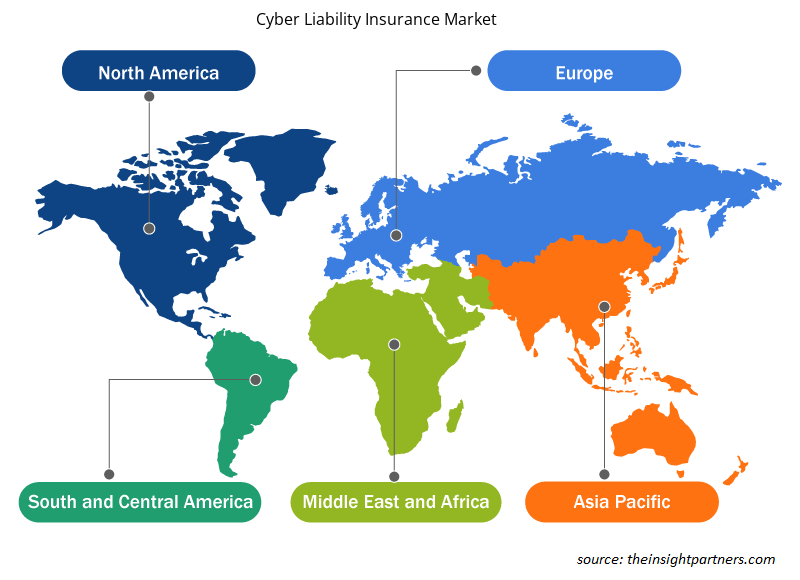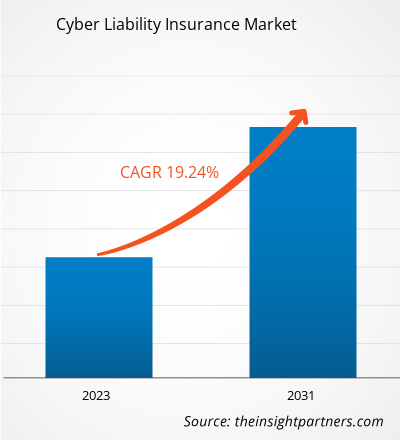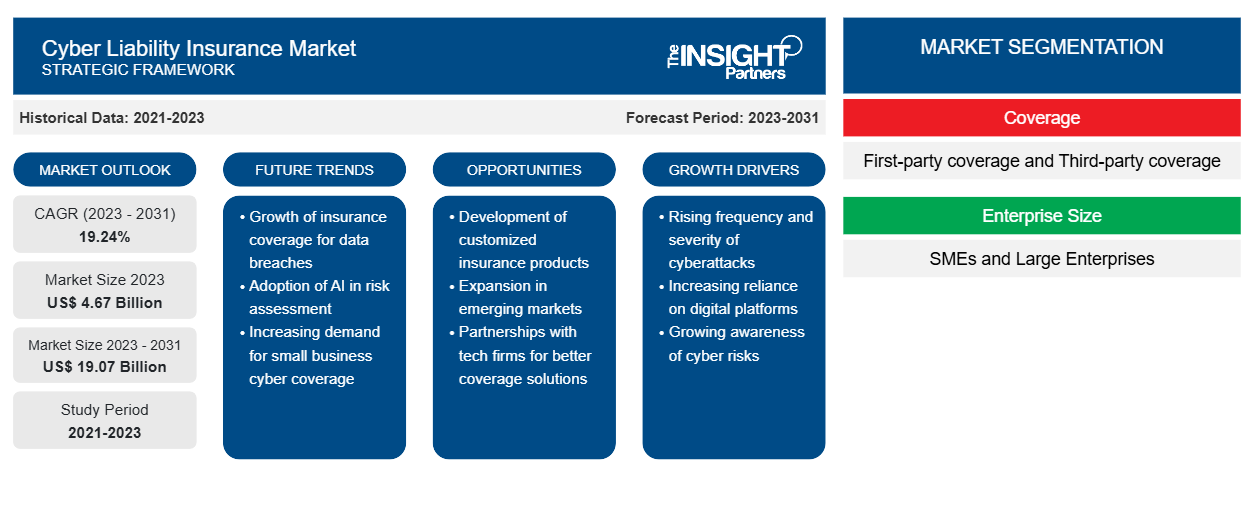사이버 책임 보험 시장은 2023년 46억 7,000만 달러에서 2031년 190억 7,000만 달러로 성장할 것으로 예상되며, 2023년에서 2031년까지 연평균 성장률 19.24%로 확대될 것으로 예상됩니다. 사이버 위협 증가 및 규정 준수와 같은 요인이 사이버 책임 보험 시장 성장을 견인하고 있습니다.
사이버 책임 보험 시장 분석
사이버 책임 보험 시장은 사이버 위협으로 인해 발생하는 증가하는 과제를 해결하기 위해 끊임없이 진화하고 있습니다. 사이버 위협이 더 광범위하고 정교해짐에 따라 사이버 책임 보험 적용 범위에 대한 수요가 증가하고 있습니다. 산업 전반의 조직은 사이버 공격으로 인한 재정적 손실과 평판 손상으로부터 자신을 보호해야 할 필요성을 인식하고 있습니다. 인공 지능 , 사물 인터넷(IoT), 운영 기술(OT)과 같은 기술의 급속한 발전은 사이버 책임 보험 시장 성장에 기회와 위험을 모두 제공합니다. 이러한 기술은 큰 이점을 제공하지만 새로운 공격 표면과 취약성을 생성합니다. 보험사는 이러한 새로운 위험을 해결하기 위한 혁신적인 적용 솔루션을 개발할 기회가 있습니다.
자동차 보험 시장 개요
- 사이버 책임 보험은 사이버 사고 및 데이터 침해로 인한 재정적 손실과 책임으로부터 기업을 보호하는 데 도움이 되는 보험 유형입니다. 사이버 공격 조사 및 시정, 법적 책임, 사업 중단, 수익 손실 및 데이터 복구와 관련된 비용, 사이버 사고와 관련된 기타 비용에 대한 보장을 제공합니다.
- 보험사는 보험 계약자에게 포괄적인 위험 관리 및 사전 침해 서비스를 제공하는 데 주력하고 있습니다. 이러한 서비스는 조직이 사이버 위험을 평가하고, 강력한 위험 관리 전략을 구현하고, 사이버 회복력을 강화하는 데 도움이 됩니다. 예를 들어, Spring Insure는 중소기업(SME)에 맞춤화된 상업용 사이버 오퍼링을 도입했으며, 여기에는 위험 관리 및 사전 침해 서비스에 대한 액세스가 포함됩니다.
- 시장에서는 보험료와 보장 범위에 변화가 있었습니다. 보험 고객은 점점 더 많은 비율로 사이버 보장을 선택하고 있으며, 이는 가격과 가용성의 조정으로 이어졌습니다. 보험사는 보장 수요를 충족하고 수익성을 유지하는 것 사이의 균형을 맞추기 위해 노력하고 있습니다. 또한 진화하는 사이버 위험과 불확실성을 해결하기 위해 보장 상품을 조정하고 있습니다.
귀하의 요구 사항에 맞게 이 보고서를 사용자 정의하세요
이 보고서의 일부 또는 국가 수준 분석, Excel 데이터 팩을 포함하여 모든 보고서에 대한 사용자 정의를 무료로 받을 수 있으며 신생 기업 및 대학을 위한 훌륭한 혜택과 할인 혜택을 이용할 수 있습니다.
-
이 보고서의 주요 시장 동향을 알아보세요.이 무료 샘플에는 시장 동향부터 추정 및 예측까지 다양한 데이터 분석이 포함됩니다.
사이버 책임 보험 시장 동인 및 기회
사이버 책임 보험 시장을 주도하는 사이버 위협 증가
- 데이터 침해, 랜섬웨어 공격, 해킹 사고와 같은 사이버 위협의 증가와 복잡성으로 인해 시장에서 사이버 책임 보험에 대한 수요가 증가하고 있습니다. 조직은 사이버 사고로 인한 재정적 손실과 평판 손상으로부터 자신을 보호해야 할 필요성을 인식하고 있습니다.
- 사이버 위협은 더욱 만연하고 진보되어 기업에 상당한 위험을 초래합니다. 민감한 정보가 침해되는 데이터 침해는 재정적 손실, 법적 책임 및 회사 평판 손상을 초래할 수 있습니다. 해커가 데이터를 암호화하고 이를 해제하기 위해 몸값을 요구하는 랜섬웨어 공격은 비즈니스 운영을 중단시키고 재정적 손실을 초래할 수 있습니다. 해킹 사고는 시스템과 네트워크를 손상시켜 민감한 데이터에 대한 무단 액세스를 허용할 수 있습니다.
사이버 책임 보험 시장 보고서 세분화 분석
- 보장 범위에 따라 시장은 제1자 보장과 제3자 보장으로 세분화됩니다. 제1자 보장 세그먼트는 2023년에 상당한 사이버 책임 보험 시장 점유율을 차지할 것으로 예상됩니다.
- 제1자 보장 세그먼트는 사이버 사고로 인해 보험에 가입한 회사의 손실과 비용에 대한 사이버 책임 보험 정책에서 제공하는 보장을 말합니다. 이 보장은 보험을 구매한 회사의 재정적 영향을 줄이기 위해 고안되었습니다. 이 보장은 보험에 가입한 회사가 데이터 침해에 대응하면서 발생하는 비용을 보장하는 데 도움이 됩니다. 여기에는 침해의 원인과 범위를 파악하기 위한 법의학적 조사, 영향을 받은 개인에게 통지, 신용 모니터링 서비스, 홍보 활동 및 법적 비용과 같은 비용이 포함될 수 있습니다.
사이버 책임 보험 시장 지역 분석
사이버 책임 보험 시장 보고서의 범위는 주로 북미, 유럽, 아시아 태평양, 중동 및 아프리카, 남미의 5개 지역으로 나뉩니다. 북미는 급속한 성장을 경험하고 있으며 상당한 사이버 책임 보험 시장 점유율을 차지할 것으로 예상됩니다. 북미 지역, 특히 미국은 북미 시장을 지배합니다. 북미는 첨단 기술 인프라와 높은 수준의 사이버 기술 도입으로 혜택을 받습니다. 이는 조직이 사이버 사고로 인한 재정적 손실과 평판 손상으로부터 자신을 보호하려고 노력함에 따라 사이버 책임 보험에 대한 필요성이 커집니다. 특히 미국은 엄격한 규제와 다양한 산업이 존재하기 때문에 사이버 보안 보험 솔루션 제공업체에게 상당한 기회를 보여줍니다. 사이버 공격은 중요 인프라 부문을 포함한 모든 규모의 기업에 상당한 재정적 영향을 미칩니다. 그 결과 북미의 조직은 사이버 책임 보험의 중요성을 점점 더 인식하고 있습니다.
사이버 책임 보험 시장 지역 통찰력
Insight Partners의 분석가들은 예측 기간 동안 사이버 책임 보험 시장에 영향을 미치는 지역적 추세와 요인을 철저히 설명했습니다. 이 섹션에서는 북미, 유럽, 아시아 태평양, 중동 및 아프리카, 남미 및 중미의 사이버 책임 보험 시장 세그먼트와 지리에 대해서도 설명합니다.

- 사이버 책임 보험 시장에 대한 지역별 데이터 얻기
사이버 책임 보험 시장 보고서 범위
| 보고서 속성 | 세부 |
|---|---|
| 2023년 시장 규모 | 46억 7천만 달러 |
| 2031년까지 시장 규모 | 190억 7천만 달러 |
| 글로벌 CAGR (2023-2031) | 19.24% |
| 역사적 데이터 | 2021-2023 |
| 예측 기간 | 2023-2031 |
| 다루는 세그먼트 |
적용 범위별
|
| 포함된 지역 및 국가 |
북아메리카
|
| 시장 선도 기업 및 주요 회사 프로필 |
|
사이버 책임 보험 시장 참여자 밀도: 비즈니스 역학에 미치는 영향 이해
사이버 책임 보험 시장은 소비자 선호도의 변화, 기술 발전, 제품 혜택에 대한 인식 증가와 같은 요인으로 인해 최종 사용자 수요가 증가함에 따라 빠르게 성장하고 있습니다. 수요가 증가함에 따라 기업은 제품을 확장하고, 소비자의 요구를 충족하기 위해 혁신하고, 새로운 트렌드를 활용하여 시장 성장을 더욱 촉진하고 있습니다.
시장 참여자 밀도는 특정 시장이나 산업 내에서 운영되는 회사나 기업의 분포를 말합니다. 주어진 시장 공간에 얼마나 많은 경쟁자(시장 참여자)가 존재하는지 그 규모나 총 시장 가치에 비해 나타냅니다.
사이버 책임 보험 시장에서 운영되는 주요 회사는 다음과 같습니다.
- 에이아이지(AIG)
- 암트러스트 파이낸셜
- AXA SA
- 츤브
- 게이코
면책 조항 : 위에 나열된 회사는 어떤 특별한 순서에 따라 순위가 매겨지지 않았습니다.

- 사이버 책임 보험 시장의 주요 주요 업체 개요를 알아보세요
"사이버 책임 보험 시장 분석"적용 범위, 차량 유형, 애플리케이션 및 지리적 위치를 기준으로 수행되었습니다. 적용 범위 측면에서 시장은 1차 적용 범위와 3차 적용 범위로 세분화됩니다. 기업 규모를 기준으로 시장은 중소기업과 대기업으로 세분화됩니다. 최종 사용자를 기준으로 시장은 BFSI, IT 및 ITES, 소매 및 전자 상거래, 여행 및 관광, 호텔 및 기타로 세분화됩니다. 지리적 위치를 기준으로 시장은 북미, 유럽, 아시아 태평양, 중동 및 아프리카, 남미로 세분화됩니다.
사이버 책임 보험 시장 뉴스 및 최근 개발 사항
회사는 시장에서 합병 및 인수와 같은 무기적 및 유기적 전략을 채택합니다. 사이버 책임 보험 시장 예측은 주요 회사 간행물, 협회 데이터 및 데이터베이스와 같은 다양한 2차 및 1차 연구 결과를 기반으로 추정됩니다. 최근 몇 가지 주요 시장 개발은 다음과 같습니다.
- 2024년 2월, 대표적인 국제 특수 보험 회사인 라이언 스페셜티(Ryan Specialty)의 도매 유통 사업부인 RT 스페셜티는 자사의 독점 디지털 플랫폼인 RT 커넥터에 사이버 책임 솔루션을 추가한다고 발표했습니다.
[출처: Ryan Specialty, LLC, 회사 웹사이트]
- 2023년 7월, 보험 중개 및 위험 관리 회사인 Risk Strategies는 사이버 위험 관리에 초점을 맞춘 새로운 서비스 제공인 Cyber Risk Management Platform(RMP)을 출시했습니다. 이 플랫폼은 기존의 외부 취약성 스캔을 넘어 고객에게 사이버 방어를 강화하기 위한 실용적인 권장 사항을 제공합니다.
[출처: Risk Strategies, 회사 홈페이지]
사이버 책임 보험 시장 보고서 범위 및 제공물
시장 보고서 "사이버 책임 보험 시장 규모 및 예측(2021-2031)"은 아래 영역을 포괄하는 시장에 대한 자세한 분석을 제공합니다.
- 범위에 포함된 모든 주요 시장 부문에 대한 글로벌, 지역 및 국가 수준의 시장 규모와 예측입니다.
- 시장 역학에는 동인, 제약, 주요 기회 등이 있습니다.
- 주요 미래 트렌드
- 자세한 PEST 및 SWOT 분석
- 주요 시장 동향, 주요 업체, 규정, 최근 시장 개발 사항을 다루는 글로벌 및 지역 시장 분석입니다.
- 시장 집중도, 히트맵 분석, 주요 업체 및 최근 개발 사항을 포괄하는 업계 환경 및 경쟁 분석입니다.
- 자세한 회사 프로필
- 과거 분석(2년), 기준 연도, CAGR을 포함한 예측(7년)
- PEST 및 SWOT 분석
- 시장 규모 가치/거래량 - 글로벌, 지역, 국가
- 산업 및 경쟁 환경
- Excel 데이터세트
최근 보고서
관련 보고서
사용 후기
구매 이유
- 정보에 기반한 의사 결정
- 시장 역학 이해
- 경쟁 분석
- 고객 인사이트
- 시장 예측
- 위험 완화
- 전략 기획
- 투자 타당성 분석
- 신흥 시장 파악
- 마케팅 전략 강화
- 운영 효율성 향상
- 규제 동향에 발맞춰 대응























 무료 샘플 받기 - 사이버 책임 보험 시장
무료 샘플 받기 - 사이버 책임 보험 시장